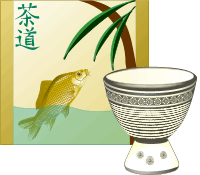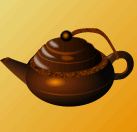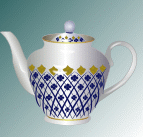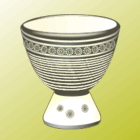A Brief History
Discover the ancient origins and fascinating history of tea!
People drink tea for many reasons. Perhaps they like the taste or maybe they are thirsty. For many people tea is a popular drink to have with friends. In many countries around the world, tea drinking is an important social occasion. Japan, China, Russia and Korea have special tea ceremonies and traditions.
Click on any of these countries to find out about their tea drinking customs:
Tea is one of the most popular drinks in Japan and a tea ceremony is a very important and special event. It is a time to relax and enjoy the loveliness of the simple things around you. There are two types of tea ceremony - the Chanoyu, sometimes called the Matcha, and the Sencha. The word 'chanoyu' means 'hot water for tea'.
The Chanoyu ceremony takes place in a wooden or bamboo teahouse called a Chashitsu. There is usually room for four guests. The garden around the teahouse is very simple with lots of green plants rather than flowers, a small rock garden, and a stream. A path winds its way through the garden leading to the teahouse. If you are invited to a Chanoyu tea ceremony there are certain rules to follow.
 First you must wait at the entrance to the garden until you are calm and ready to enter. The Teishu or tea master welcomes you when you are in the garden. He or she brings fresh water for you drink and to wash your hands. Now you follow the Teishu along the path to the teahouse.
First you must wait at the entrance to the garden until you are calm and ready to enter. The Teishu or tea master welcomes you when you are in the garden. He or she brings fresh water for you drink and to wash your hands. Now you follow the Teishu along the path to the teahouse.
Inside the teahouse, the Teishu makes the tea using powdered green tea called 'matcha'. The tea is mixed with boiled water using a bamboo whisk and served in small bowls.
Guests sit on the floor around a low table. When the Teishu gives you your tea, bow, take your bowl with your left hand, and then hold it with your right hand. Place the bowl in front of you and turn it to the right so that you don't drink from the side that was facing you. Usually the Teishu gives you a sweet cake or a mochi to eat as well because the tea is bitter.
When you have finished your tea turn the bowl to the left and place it on the table in front of you - you must drink it all! You turn the bowl to show the Teishu respect: it means that the edge of the cup he gave you was the best, but you are not good enough to drink from that side. Sometimes the guests share one bowl that they pass around.
The Sencha ceremony, is more relaxed than the Chanoyu ceremony. The rules for serving the tea are traditional but the occasion is more easy-going for the tea drinkers.
Most people in Japan don't have their own teahouse but they often belong to a 'tea club' where they go every week to take part in the tea ceremony.
The art of drinking and serving tea is an important and special event in China. It is a time to relax and enjoy the taste and the smell of the tea.
The Chinese tea ceremony is all about the tea. The smells and taste are the most important parts of the ceremony, so the rules for making and pouring the tea are not always the same.
In most areas of China the tea is made in small clay teapots. The pot is rinsed with boiling water and then the tea leaves are added to the pot using chopsticks or a bamboo scoop. The tea leaves are rinsed in hot water in the pot and then hot water is added to the leaves to make the tea.
 The temperature of the water is important. It needs to be hot but if it is too hot it can spoil the taste. The art of preparing and making tea is called Cha Dao.
The temperature of the water is important. It needs to be hot but if it is too hot it can spoil the taste. The art of preparing and making tea is called Cha Dao.
In less than a minute, the server pours the tea into small narrow cups but he doesn't pour one cup at a time. Instead the cups are arranged in a circle and the server pours the tea in all of them in one go.
He fills the cups just over half way. The Chinese believe that the rest of the cup is filled with friendship and affection.
The server passes a cup to each guest and invites him or her to smell the tea first. You should thank him by tapping on the table three times with your finger. Next each guest pours their tea into a drinking cup and they are asked to smell the empty narrow cup. Finally they drink the tea.
It is most polite to empty the cup in three swallows.
When you drink tea in a teahouse or restaurant is it called Yum Cha, yum is to drink and cha is tea.
Tea is probably the favourite drink in Russia. It is made and served in teapots or samovars - a Russian tea kettle.
In some areas they use three teapots that sit on top of each other to keep the tea warm. Often they are decorated with pictures from Russian folk stories and sometimes, they are made in the shape of something so that when they fit together they look like a person or an animal.
Three teapots are used when you want to make two different kinds of tea at the same time.
The middle pot usually holds strong black tea, the smallest pot on the top holds herbal or mint tea, and the large pot on the bottom holds hot water. The teas can be mixed with each other and diluted with hot water as you pour out each cup. Everyone can mix the type of tea they like.
Tea is drunk from a special glass called a stakan which is usually held in a silver metal holder called a podstakannik.
In Russia, tea is usually drunk after meals rather than with a meal but when tea is made using a samovar it is ready to be used all day long. A samovar is shaped like an urn and there is a special place for a small teapot to sit on the top.
 Water is heated in the samovar and a strong dark tea is made using lots of tea leaves in the teapot on top. The strong tea is called zavarka. The tea is so strong that it has to be diluted with water from the samovar before you can drink it.
Water is heated in the samovar and a strong dark tea is made using lots of tea leaves in the teapot on top. The strong tea is called zavarka. The tea is so strong that it has to be diluted with water from the samovar before you can drink it.
You mix a drop of tea with hot water taken from the tap or spout on the front of the samovar. As the water is used you need to refill the samovar and every few hours you have to make a fresh pot of black tea.
Some samovars are small and only hold about three litres of water but some can hold up to 30 litres. Samovars are usually made from metal. You can see them in homes, in offices and in restaurants.
Tea is one of the most popular drinks in Korea. Tea ceremonies were first held in Korea more than a thousand years ago.
They are still recognised today as special occasions by Buddhist monks and ordinary people.

The ceremonies in Korea are similar to those held in Japan and China but they are not as formal as the ceremonies in Japan. Korean Buddhists monks spend many hours meditating - thinking about their religion and their life. They use the tea ceremony to help them meditate.
Ordinary people also feel that tea ceremonies are spiritual occasions that are closely associated with their religion. 'Tea,' they say, 'is a healthy, enjoyable and stimulating drink, full of good qualities. It reduces loneliness and calms your heart; it is a comfort in everyday life'.
There are tea rooms in most cities and even small towns in Korea where friends can gather and drink tea together.
Many Koreans today still have tea ceremonies for important occasions including special birthdays and anniversaries.
From 1392-1910, tea ceremonies were performed regularly at palaces in Korea. The "Day Tea Rite" was a common daytime ceremony, but the "Special Tea Rite" was reserved for specific occasions, including royal weddings and visits from leaders of other countries.
There was one tea ceremony, however, that the king was not invited to. This was the Queen Tea Ceremony. The only male guest was the crown prince, the eldest son of the Queen. The other guests were female friends, family and servants of the Queen.